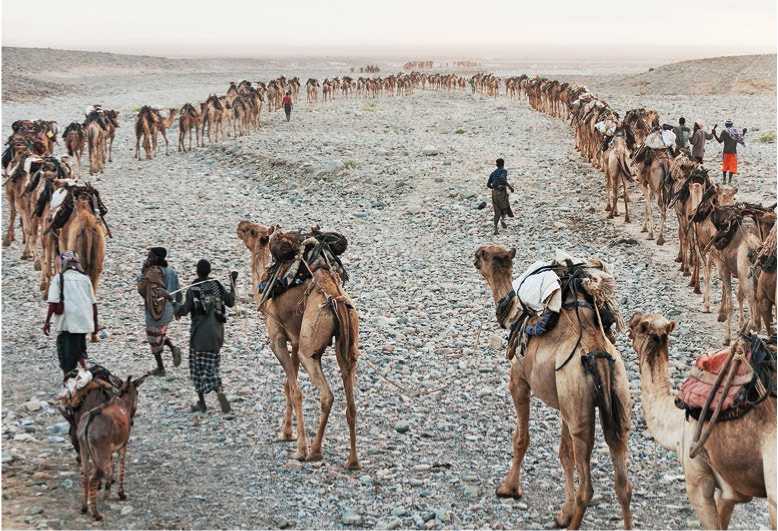In the period between 4000 and 1000 bce, Europe, Egypt, northern India, and China were developing into chiefdom societies, city-states, and even in some places into kingdoms. In this period we see amazing architectural accomplishments: Stonehenge in England (ca. 3000 bce), Zoser’s mortuary tomb complex in Egypt (ca. 2650 bce), the ziggurat of Ur in Mesopotamia (ca. 2000 bce), and the first great cities in China and northwest India. But in this period major ecological changes took place that resulted in the growth of the steppe of Inner Asia across 4,500 kilometers, in efiect cutting Asia into two segments. The great steppe paralleled in many ways the already existing Sahara Desert and can be combined into a single geographical horizon. This area was not a place where agriculture could find a foothold, nor was it a place where First Society people could flourish, as their existence depended on the availability of a variety of seasonal food sources. The result was a huge expanse of land that was largely empty of people. In the year 3000 bce, for example, a person leaving the west coast of Africa could have traveled to eastern Mongolia 12,000 kilometers away without encountering any notable settlements, except when crossing the Nile and Mesopotamia. Other than that, apart from an occasional group of herders, it would have been a rather lonely trek. Nowhere else in the entire world was there such an unpopulated expanse, not even in the cold tundra regions of Siberia and northern Canada, which were home to the widespread hunting and fishing cultures (Figure 13.1).
The character of this huge transcontinental zone changed considerably when two tamable animals were put in the service of man, the horse and the camel, the first becoming the master of the steppe and the second the master of the desert. Prior to about 3000 bce, the horses had been largely hunted for food, but eventually it was discovered that it could be ridden, herded, milked, deployed in war raids, and even attached to chariots. This development began in the western steppe and spread both southward and eastward.
In its southward formation, it encountered the great urban world of Mesopotamia and quickly became integrated into the political formations there.
The Scythians, Parthians, and Sassanians were all horse riding cultures. The horse was adopted by the Egyptians under harnesses II (1303-1213 bce) to dominate West Asia. The horse had an equally dramatic impact in India and in some places is itself worshiped as a deity.
Meanwhile, the dromedary, the one-humped camel, was domesticated by desert Arabs in present-day Iraq and Saudi Arabia in the third millennium bce. It was an essential element in the burgeoning spice trade that linked Ethiopia and Yemen to the Mediterranean and the Caucasus. We see the first representations of the camel, such as in a stone relief that was found in the northern Syria site of Tell Halaf. Decorating the facade of a temple-palace that was built in the tenth century bce, it depicts an Arabic trader perched atop the hump of a dromedary camel, urging it on with a stafil Crossed bands securely fasten the saddle onto the animal. The curving neck, rounded body, and unevenly placed hooves re-create the rocking sensation of a camel in motion.
Figure 13.2: Camel caravan, Ethiopia. Source: Markus Fleute

The impact of the dromedary remained relatively restricted to Mesopotamia and connecting regions until about 800 bce, when the two-humped Bactrian camel was pulled into human service to connect Mesopotamia to China, opening the pathways across huge stretches of desolate regions. Here, along the Silk Route, in Central Asia, the camel and the horse came to be integrated, producing a unique and powerful cultural formation with huge impact on Central Asian history. The Wei Dynasty (386-ca. 550 bce), for example, was found by Tabgatch, who were Turk nomads inhabiting the frontiers of northern China and controlling the oases and trading centers that served the trade routes to Central Asia. They conquered the small, weak states of north China in the late fourth century bce and were clearly regarded by the Chinese as foreign invaders. Having no administrative structure of their own, however, they were forced to rely on Chinese civil servants to help govern the country. Their tombs, which were stone structures placed in underground vaults, were decorated with elaborate murals of horsemen and with clay representations of camels, some of the earliest representations of that animal in China.
A second camel revolution took place in the northern part of Africa, but not until after 300 ce, with the Tuareg in Algiers forming more or less at the same time as the Mongolians for the east. Although these African nomads were not First Society people, certain aspects of their culture remained founded in ancient ways, and in particular their attachment to animism. The camel cultures of Central Asia, however, generally embraced Buddhism and fused it with their traditional beliefs. In Africa, the camel tenders generally embraced Islam and likewise integrated it with their animistic foundations (Figure 13.2).
The nomads of the steppe and deserts perfected an architecture of either portable huts or tents. The Mongolians in east Asia and the Rendille in Africa both developed the former, whereas others made tents, based on the foundations of the ancient sheep-herding tradition. Though the hut and tent come in multiple variations, all are designed to be packed and moved, and in almost all cases all are owned by—or associated with—the wife, usually through marriage. A comparison should be made with the tipi of the Plains Indians. Whereas the Plains Indians moved camp in order to follow bison, African/Eurasian nomads were not hunters but breeders, traders, and raiders. The tipi could be easily erected, but it came into being only with the development of dog sleds that could move the bulky poles from camp to camp. The Mongolian ger was originally designed to be moved on a camel or transported by means of a cart pulled by oxen. Though its frame was lightweight, it was a winterized structure with heavy felt coverings. Tents are a different matter altogether since they are, of course, not built on the principle of structure and covering, but on the tensile capacities of cloth. Unlike the traveler from 3000 bce, the traveler leaving Morocco and heading to north China around 500 ce would have made the entire journey on the back of a camel moving from one caravan to another. It might
Not have been easy. The risks were numerous and there were still large expanses of empty landscape. But the caravan leaders would know where the watering holes were and where the local chiefdoms existed, and which areas were safer to pass than others.
And it was not just trade that was opened up, but a whole new civilizational horizon. For centuries cultures built on the principle of mobility continued to impact if not actually define the history of Asia, Europe and North Africa up almost until the arrival of the modern era. The horse changed military strategy even in places far from the steppe. The chariot became a widely-used symbol of power and the camel facilitated the flow of ideas and technologies.




 World History
World History









